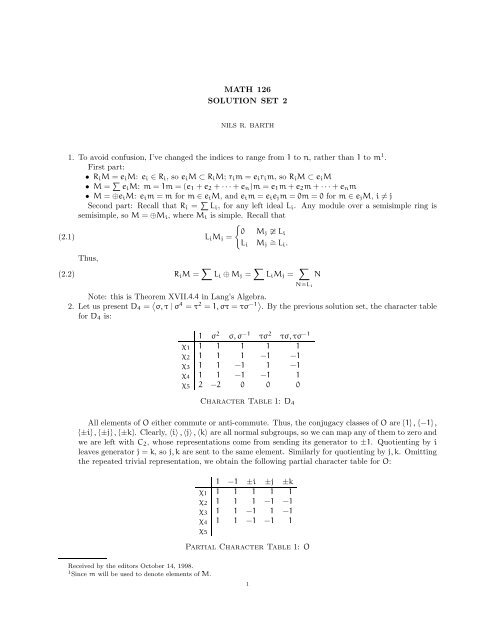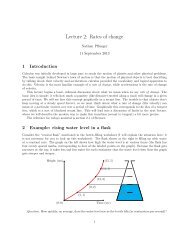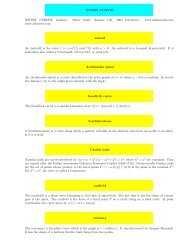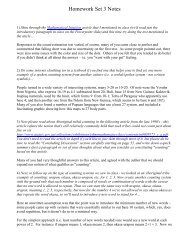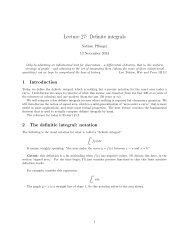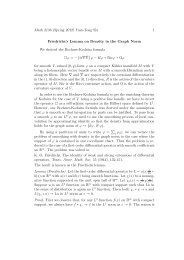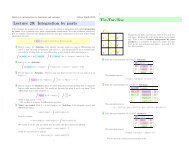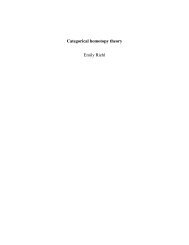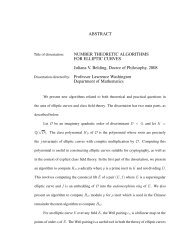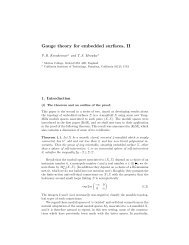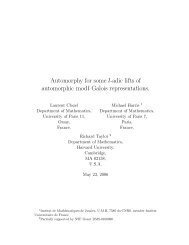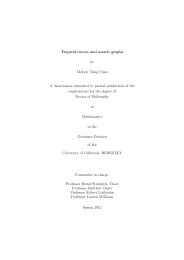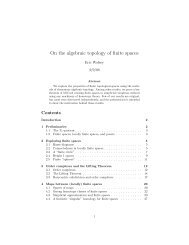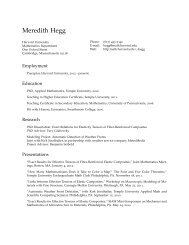Math 126 Solution Set 2
Math 126 Solution Set 2
Math 126 Solution Set 2
You also want an ePaper? Increase the reach of your titles
YUMPU automatically turns print PDFs into web optimized ePapers that Google loves.
(2.1)<br />
(2.2)<br />
MATH <strong>126</strong><br />
SOLUTION SET 2<br />
NILS R. BARTH<br />
1. To avoid confusion, I’ve changed the indices to range from 1 to n, rather than 1 to m 1 .<br />
First part:<br />
• RiM = eiM: ei ∈ Ri, soeiM ⊂ RiM; rim = eirim, soRiM ⊂ eiM<br />
• M = eiM: m = 1m =(e1 + e2 + ···+ en)m = e1m + e2m + ···+ enm<br />
• M = ⊕eiM: eim = m for m ∈ eiM, andeim = eiejm = 0m = 0 for m ∈ ejM, i = j<br />
Second part: Recall that Ri = Li, for any left ideal Li. Any module over a semisimple ring is<br />
semisimple, so M = ⊕Mi, whereMi is simple. Recall that<br />
Thus,<br />
LiMj =<br />
<br />
0 Mj ≇ Li<br />
Li Mj ∼ = Li.<br />
RiM = Li ⊕ Mj = LiMj = <br />
Note: this is Theorem XVII.4.4 in Lang’s Algebra.<br />
2. Let us present D4 = σ, τ | σ 4 = τ 2 = 1, στ = τσ −1 . By the previous solution set, the character table<br />
for D4 is:<br />
N∼ =Li<br />
1 σ 2 σ, σ −1 τσ 2 τσ, τσ −1<br />
χ1 1 1 1 1 1<br />
χ2 1 1 1 −1 −1<br />
χ3 1 1 −1 1 −1<br />
χ4 1 1 −1 −1 1<br />
χ5 2 −2 0 0 0<br />
Character Table 1: D4<br />
All elements of O either commute or anti-commute. Thus, the conjugacy classes of O are {1} , {−1} ,<br />
{±i} , {±j} , {±k}. Clearly, 〈i〉 , 〈j〉 , 〈k〉 are all normal subgroups, so we can map any of them to zero and<br />
we are left with C2, whose representations come from sending its generator to ±1. Quotienting by i<br />
leaves generator j = k, soj, k are sent to the same element. Similarly for quotienting by j, k. Omitting<br />
the repeated trivial representation, we obtain the following partial character table for O:<br />
1 −1 ±i ±j ±k<br />
χ1 1 1 1 1 1<br />
χ2 1 1 1 −1 −1<br />
χ3 1 1 −1 1 −1<br />
χ4 1 1 −1 −1 1<br />
χ5<br />
Received by the editors October 14, 1998.<br />
1 Since m will be used to denote elements of M.<br />
Partial Character Table 1: O<br />
1<br />
N
MATH <strong>126</strong> SOLUTION SET 2 2<br />
The last row is uniquely determined by its dimension (which must be 2), and orthogonality 2 . Since<br />
the first four rows agree with the character table for D4 and the conjugacy classes have the same size,<br />
the last row must agree as well. Thus, O has character table:<br />
1 −1 ±i ±j ±k<br />
χ1 1 1 1 1 1<br />
χ2 1 1 1 −1 −1<br />
χ3 1 1 −1 1 −1<br />
χ4 1 1 −1 −1 1<br />
χ5 2 −2 0 0 0<br />
Character Table 2: O<br />
Last, we must verify that D4 ≇ O. This is because the former has two elements of order 4, while<br />
the latter has six. Thus, non-isomorphic groups can have the same character table.<br />
3. The character table for S4 is:<br />
1 (2) (3) (4) (2, 2)<br />
χ1 1 1 1 1 1<br />
χ2 1 −1 1 −1 1<br />
χ3 2 0 −1 0 2<br />
χ4 3 1 0 −1 −1<br />
χ5 3 −1 0 1 −1<br />
Character Table 3: S4<br />
The first two representations are the trivial and sign, the fourth comes from decomposing the<br />
permutation representation: χπ = χ1 ⊕ χ4, the fifth from tensoring the sign and fourth: χ5 = χ1 ⊗ χ4,<br />
and the third follows from dimension and orthogonality.<br />
4. The commutator of Sn is An, so the one dimensional representations of Sn correspond to representations<br />
of Sn/An = C2, and are thus the trivial and sign representations.<br />
S1,S2 are commutative, so they have no simple two dimensional representations, S3 ∼ = D3, and its<br />
simple two dimensional representation is on solution set 1.<br />
For S4, note that the double conjugations (the elements of the form (ab)(cd)) form a normal<br />
subgroup of order 4 (in fact the Klein 4-group), so quotienting out by them gives a group of order<br />
24/4 = 6, which is non-commutative, as we haven’t quotiented out by An. Thus, the quotient is S3,<br />
and composing the quotient with the simple representation of S3 yields a simple representation of S4.<br />
By inspecting the character table, this is the only simple two dimensional representation.<br />
For n>4, Sn has no proper normal subgroups other than An. Thus, the kernel of any representation<br />
must be 1, An,Sn. The latter two correspond to the sign and trivial representations. Thus, any other<br />
simple representation must be faithful.<br />
Take two disjoint 2-cycles, say (12), (34). These are commuting and diagonalizable, and are thus<br />
simultaneously diagonalizable. Thus, ρ(12) = <br />
±1 0<br />
0 ±1 and similarly for (34). However, they cannot be<br />
sent to ±I, as they then would commute with everything and this representation would not be faithful.<br />
In particular, if (12) is sent to ±I, thenρ(1234) =ρ (12)(1234)(12) = ρ(2134) and the representation<br />
will not be faithful. The same holds for (34) and (12)(34). Thus,ρ (12) = ± <br />
1 0<br />
0 −1 and similarly for<br />
(34). Butthenρ (12)(34) = ±I (since they are simultaneously diagonalizable), which cannot happen,<br />
by the above reasoning. Thus, for n ≥ 5, Sn has no simple two dimensional representations.<br />
The above can be generalized. What we did was find a commutative subgroup of Sn, all of whose<br />
elements have order 2. Thus, their image is simultaneously diagonalizable, and there are thus 2d possible elements of the image (d is the dimension of the representation). However, none of these<br />
elements can be −I, as this representation would then fail to be faithful. Since we can always find<br />
r = <br />
n<br />
r<br />
2 disjoint 2-cycles, the subgroup they generate has order 2 elements, which must be mapped<br />
injectively into a set of size 2d −1. Thus,forn≥5, simple representations of Sn (other than the trivial<br />
and sign) must have dimension > <br />
n<br />
2 .<br />
2 Actually, it is uniquely determined by orthonormality and the need for the first entry to be positive.


